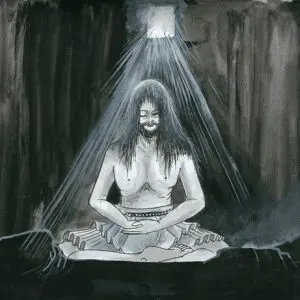
История жизни Кхентрула Ринпоче Джампэла Лодрё
Кхентрул Ринпоче считается третьим воплощением великого адепта Калачакры Нгаванга Чозина Гьяцо. Поначалу будучи скромным пастухом-кочевником, Ринпоче прошел через поистине необыкновенный жизненный опыт. Приведенная ниже хронология выделяет некоторые ключевые события, которые помогли ему стать тем, кем он является сейчас.
Особое примечание: у Кхентрула Ринпоче были различные видения от его личного божества, которые указывали ему исходить из разных дат рождения в разное время. Более поздние даты на временной шкале верны, но дата рождения Ринпоче, которую мы приводим, варьируется в зависимости от его указаний для личной практики.
1967
Признаки предстоящего воплощения
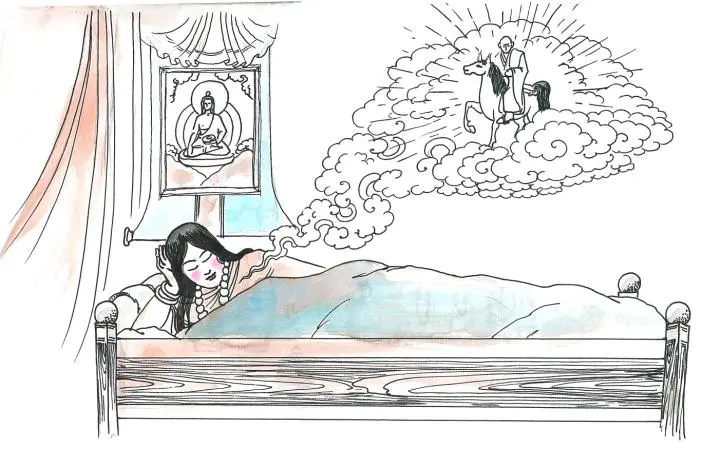
Еще до рождения Ринпоче его родители получили благоприятные знаки о том, что скоро в их семье родится особенное существо. Однажды отец Ринпоче отправился навестить высокореализованную йогини по имени Таре Лхамо, которая считалась эманацией великой Еше Цогьял. Не успел он дойти до деревни, как Таре Лхамо внезапно появилась перед ним. Отец Ринпоче сделал простирания и поднес ей шарф для благословения. Приняв его чистое подношение, она одарила его драгоценными дарами: лекарственными пилюлями, защитными шнурами и письмом, свернутым в свиток.
Придя домой, он открыл письмо и обнаружил, что в нем содержатся различные предсказания. В нем говорилось, что отец Ринпоче проживет не очень долгую жизнь, но обретет перерождение как великий тантрический практик в северном Тибете. В нем также говорилось, что мать Ринпоче является великим существом, и хотя ей выпала тяжелая жизнь, в ней содержатся семена для рождения многих великих существ. Однако условия складываются так, что только одно из этих существ станет высокореализованным; и произойдет это, когда он будет в среднем возрасте.
В другой раз матери Ринпоче приснился яркий сон о ее любимом мастере Геце Кхентруле, который был заключен в тюрьму во время Культурной революции. В ее сне он был одет в белый халат и ехал на белой лошади, приближаясь к ее палатке. Она была удивлена его внешним видом, ведь он всегда носил традиционную бордовую одежду монаха. Он остановился у порога ее шатра, привязал коня и вошел внутрь. Она заметила, что Геце Кхентрул по-прежнему держит при себе монашеские одежды, но носит их в сумке. Он сел на белую подушку, и люди, которых она не узнала, поднесли ему мандалу. По окончании церемонии мать Ринпоче вышла из шатра и заметила, что белая лошадь исчезла. Когда она проснулась, у нее было четкое ощущение, что скоро она снова увидит своего учителя.
Позже она узнала от своего мужа, что ему тоже приснился точно такой же сон, в котором он и брат Геце Кхентрула, Геце Вару, совершили подношение мандалы учителю в белой одежде. Пораженные этим удивительным совпадением, супруги рассказали о сне своим друзьям. Когда известие дошло до Геце Вару, он подтвердил, что в ту же ночь ему приснился тот же сон. Эти и другие признаки ясно указывали на приход особого воплощения.
1968
Благоприятное рождение
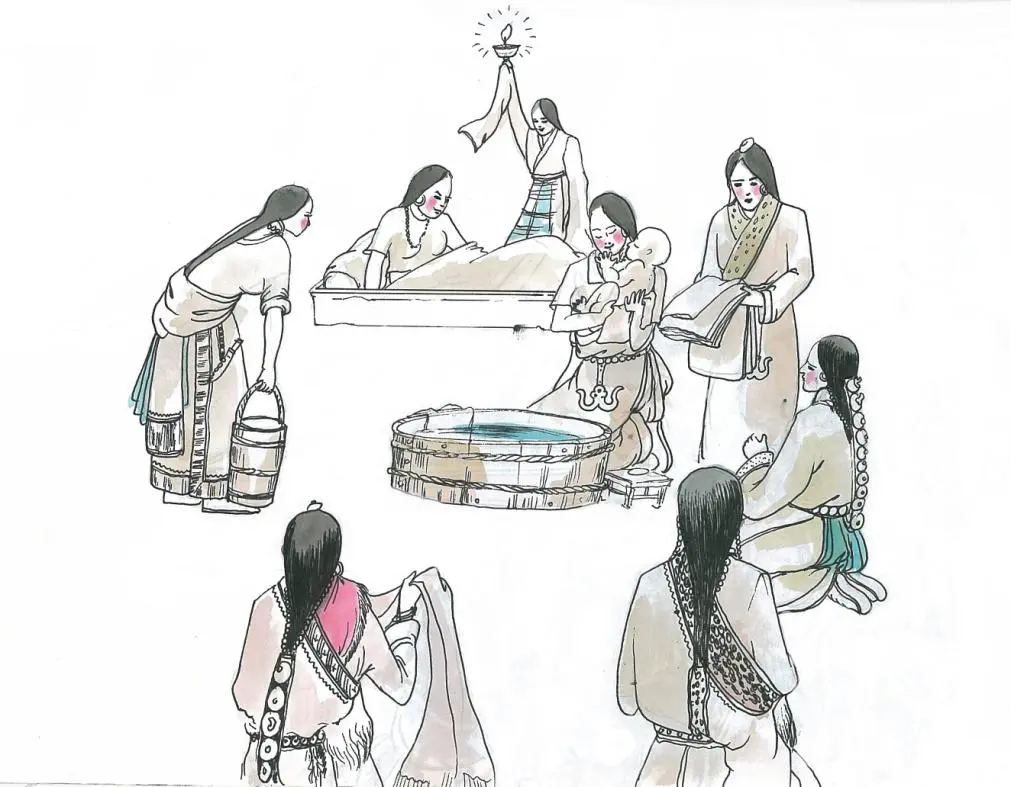
Ринпоче родился 18 апреля 1968 года в год Земляной Обезьяны в долине Дера у реки Мачу. Жители деревни вспоминали, что в день его рождения погода была необычайно мягкой, и в небе кружили подобные лепесткам лотоса снежинки. У его матери не отошли воды во время родов, и он родился в совершенно неповрежденном амниотическом мешке. Это очень редкое явление, которое случается лишь один раз на каждые 80 000 родов. Помощники также были удивлены, увидев, что его пуповина не была прикреплена к плаценте. Говорят, что он не плакал, как многие новорожденные, а вместо этого улыбался своей матери и ее помощницам. Несколько детей из деревни сказали, что видели, как над семейным шатром появилась радуга, пока его мать рожала.
На четвертый день после рождения Ринпоче в их семейную палатку прибыл незнакомец. Его встретили как обычно и пригласили войти. Когда он снял свое длинное пальто, все присутствующие увидели, что он был одет в традиционные красные одежды монаха. Незнакомец спросил, может ли он навестить мать и ребенка в родильном шатре. Отец Ринпоче дал ему разрешение, но только потому, что тот был монахом. Войдя в родильный шатер, монах поклонился матери Ринпоче и начал петь благословения. Затем он подошел ближе и окропил тело ребенка благословленной водой. После этого он ушел так же внезапно, как и появился. Никто не успел спросить, кто он и откуда пришел.
Несколько дней спустя другой посетитель, известный как Кьянгья, совершил опасное путешествие через замерзшую реку, чтобы навестить Ринпоче и дать свои благословения. Тогда он сказал матери Ринпоче, что, по его мнению, Геце Кхентрул действительно перевоплотился как ее ребенок. Он провел церемонию, чтобы защитить семью и ребенка, а затем прочитал эпическую историю Гесара из Линга в честь этого события.
1973
Тайное признание воплощением Геце Кхентрула

Будучи еще маленьким ребенком, Ринпоче демонстрировал уникальные способности. Говорят, что когда ему был всего один год, Ринпоче произнес мантру Манджушри в качестве своих первых слов. Научившись ходить, он выходил на открытые пространства, где читал мантры под развевающимися на ветру молитвенными флагами. Однажды, когда ему было три года, Ринпоче увидел четки на алтаре своей матери и провозгласил: «Хе! Это мои!» На что его мать ответила: «Да, но ты отдал их мне». Словно вспомнив, он сказал: «О, да» и положил четки обратно на алтарь.
Когда Ринпоче было пять лет, его семья посетила известного в этой местности мастера, известного как Гьярунг Самдруп. Мать Ринпоче провела некоторое время у этого ламы, чтобы преодолеть мучившую ее болезнь. В то время Гьярунг Самдруп видел множество снов о Геце Кентруле, подтверждающих, что Ринпоче является его непосредственным воплощением. Он также сделал ряд предсказаний о том, что у Ринпоче будет долгая жизнь, и в будущем он станет великим учителем Дхармы, принося невероятную пользу бесчисленным живым существам.
В эти ранние годы многие ламы, которых посещали родители Ринпоче, предостерегали их, чтобы они держали статус Ринпоче в секрете. Они предупреждали, что если его публично признают переродившимся ламой, он испытает большие трудности и препятствия в своей жизни. Следуя этому совету, Ринпоче воспитывался как обычный ребенок в общине кочевников.
1976
Простая жизнь пастуха яков
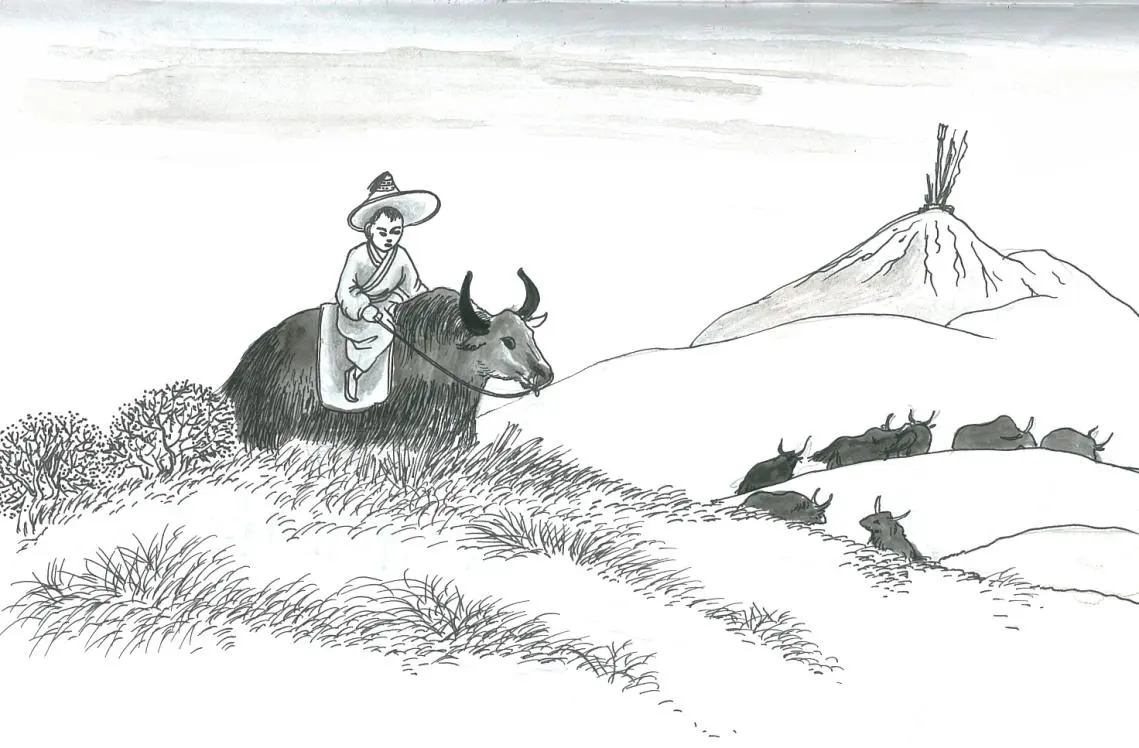
В возрасте восьми лет Ринпоче стал пасти семейных яков. Вместе с отцом они проводили долгие дни в горах, присматривая за животными. Однажды стая волков напала на стадо и убила восемь яков. Ринпоче с великой преданностью помолился манифестации Тары, известной как Маричи, и волки вскоре ушли. С того дня всякий раз, когда он пас яков, он молился Маричи, повторяя ее мантру. После этого заботиться о животных стало легко, и им больше ничего не угрожало.
В один прекрасный день Ринпоче пас животных на горе. Цветы благоухали в изобилии, свежая трава была зеленой и сочной, а в деревне царила атмосфера умиротворения. Когда он лежал на земле, красота этого места напомнила ему историю о знаменитом индийском принце по имени Дриме Кунден. Принц славился своей щедростью и состраданием. Вспоминая о его великом милосердии и самопожертвовании, Ринпоче уснул.
Во время сна он услышал прекрасную музыку и внезапно проснулся. Взглянув на небо, он увидел принца Дриме Кундена с женой и детьми, танцующих в облаках. Принц был одет в красивую белую струящуюся мантию, волосы его были завязаны на макушке в идеальный узел — совсем как у индийского принца. У принцессы были длинные, черные, сияющие волосы, на ней было платье из тонкого шелка, инкрустированное драгоценными камнями, задрапированное тонко вышитой шалью. Двое их сыновей были одеты в яркие индийские шелковые одежды. Все они мечтательно парили в облаках, но Ринпоче переживал это видение, находясь в полном сознании. На следующие несколько часов он погрузился в глубокое и ясное состояние медитации, не похожее ни на что, испытанное им ранее.
Когда Ринпоче немного подрос, он начал изучать буддизм с монахом, который жил в его семье. Во время учения о Будде Медицины Ринпоче часто поправлял монаха, указывая наразличные ошибки в произношении. Он также продемонстрировал знание многих сложных предметов, которым его не учили в той жизни. Молва о естественном знакомстве Ринпоче с Дхармой быстро распространилась.
1986
Смерть отца и принятие монашества
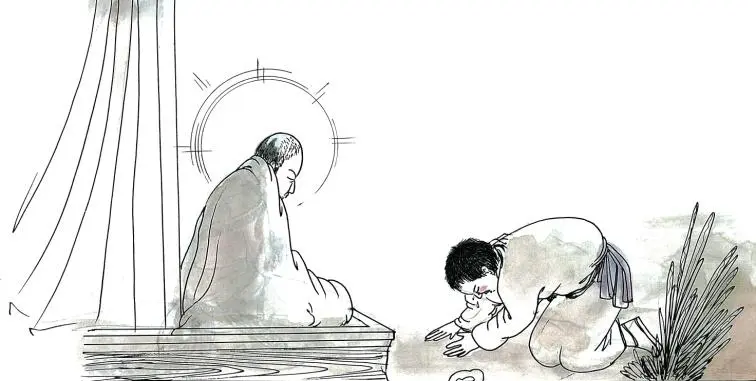
После долгих лет запрета тибетцам в конце концов разрешили начать восстанавливать свои монастыри. Отец Ринпоче вызвался помочь в восстановлении монастыря Денунг и проделал огромный путь, чтобы внести свой посильный вклад. Прошло некоторое время, и Ринпоче решил присоединиться к отцу. Когда Ринпоче наконец приехал, то обнаружил, что отец болен. Его состояние вскоре ухудшилось, и все боялись, что он умрет. Вскоре после этого приехала мать Ринпоче, она рассказала, что видела ряд неблагоприятных предзнаменований. К сожалению, по правилам монастыря ей не разрешили остаться с мужем.
Однажды утром отец Ринпоче попросил его приготовить место, чтобы он мог сесть в позу для медитации. Он был слаб, но мог ходить с посторонней помощью, поэтому Ринпоче помог ему занять место, где, судя по всему, ему было удобно. Через некоторое время отец сказал: «Все белое!» и жестом показал перед собой. Он повторил это еще раз, а затем слегка наклонился вперед. Через пятнадцать минут, когда в комнату вошел монах и сказал ему, что он должен просто оставить тело в покое, Ринпоче понял, что его отец скончался.
До смерти отца Ринпоче сомневался, стоит ли ему становиться монахом. Однако после смерти отца он почувствовал, что теперь у него не осталось выбора. Ему казалось, что если он не станет монахом, то его мать умрет от разрыва сердца. Смерть отца послужила катализатором, Ринпоче встал на колени, поклонился телу отца и пообещал стать монахом, чтобы исполнить заветное желание своих родителей.
После завершения периода траура по отцу Ринпоче получил во сне ряд благоприятных знаков, которые указывали на то, что ему пора стать монахом. В семнадцать лет Ринпоче отправился в монастырь Денунг и попросил ламу Тулку Катага даровать ему посвящение. В то время пятнадцать других монахов ожидали посвящения. Лама счел время просьбы Ринпоче благоприятным, поскольку это означало, что шестнадцать монахов будут посвящены в сан, что соответствует шестнадцати архатам, которые были главными учениками Будды. Церемония была проведена на следующий день.
Ринпоче и других претендентов посвящали в сан небольшими группами, всего по три монаха за раз. Во время церемонии рукоположения, как и положено по обычаю, каждый вытянул имя из шляпы. К удивлению Ринпоче, он вытянул имя учителя ламы Тулку Катага — Амдо Геше, который также был известен как Джампэл Ролви Лодрё. Тулку Катаг сообщил Ринпоче, что теперь его имя для посвящения в сан будет Джампэл Лодрё, имя одновременно благоприятное и драгоценное.
1987
Учась быть монахом
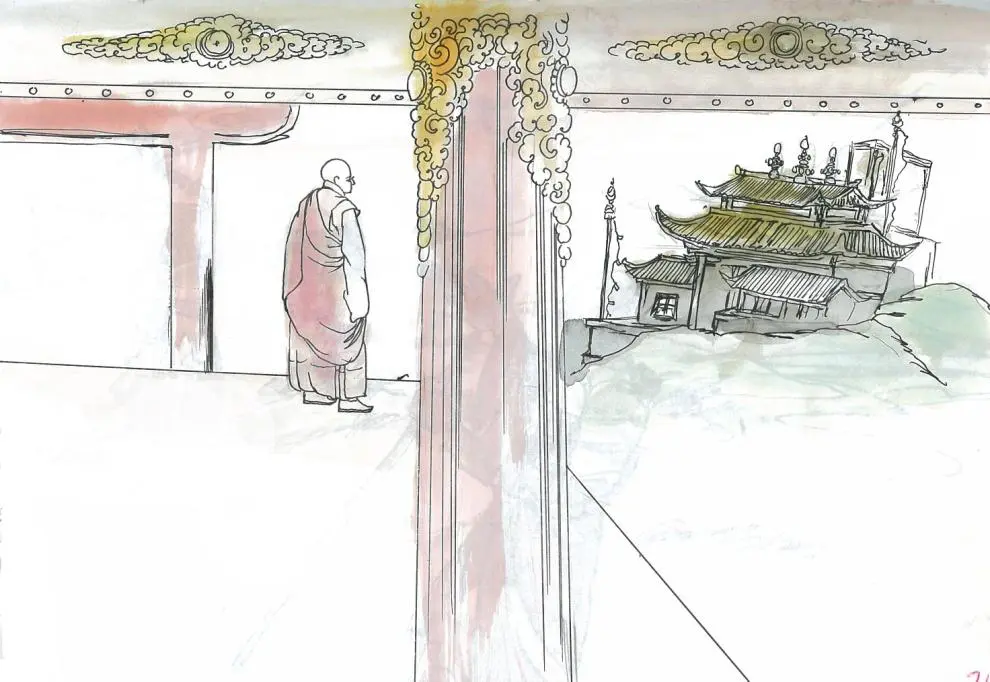
Желая начать свое монашеское обучение, Ринпоче обратился к наставнику принимающему обеты и попросил учения по полному собранию из двухсот сорока обетов, которые представлены в своде буддийской монашеской дисциплины (Винае). Очень довольный чистым намерением Ринпоче, Тулку Катаг четыре дня продолжал давать Ринпоче и еще нескольким монахам учения по обетам. Он похвалил Ринпоче за его проницательность и сказав, что было важно, чтобы он попросил дать это учение, предложил ему рукописный перечень тридцати шести обетов с дополнительными комментариями.
Вернувшись ненадолго домой, чтобы провести ритуалы для своего недавно умершего брата, Ринпоче отправился в монастырь Дхартханг, чтобы продолжить свое обучение. В отличие от небольших монастырей, в которых Ринпоче ранее проводил ретриты, Дхартханг был большой монашеской общиной, в которой проживало несколько сотен монахов. В Дхартханге Ринпоче получил учения по книге Нгари Панчена «Утверждение трех обетов», в которой содержался подробный комментарий к монашеским обетам и обязательствам, а также к обетам и обязательствам колесниц Бодхисаттв и Тантры.
Большую часть своих дней он проводил в долгих сессиях воспевания молитв. Когда давались учения, они обычно состояли из чтения учителем текста с небольшими пояснениями, если таковые вообще были. По вечерам ученики должны были разучивать тексты. В последующие дни их проверяли, насколько они усвоили материал. Поскольку Ринпоче изучал многие из этих материалов с Ламой Тулку Катагом, по ночам он часто учил своих соседей по комнате.
Жизнь в Дхартханге оказалась для Ринпоче довольно сложной. В то время как большинство монахов приняли посвящение в детстве, Ринпоче стал монахом в более позднем возрасте. Этот факт, в сочетании с природным мастерством Ринпоче в Дхарме, вскоре породил напряженность в отношениях с некоторыми из его руководителей, которые чувствовали угрозу от присутствия Ринпоче. В то время как Ринпоче хотел сосредоточиться только на своих исследованиях, он часто оказывался втянутым во внутреннюю политику монастыря.
1987
Посвящение себя учебе
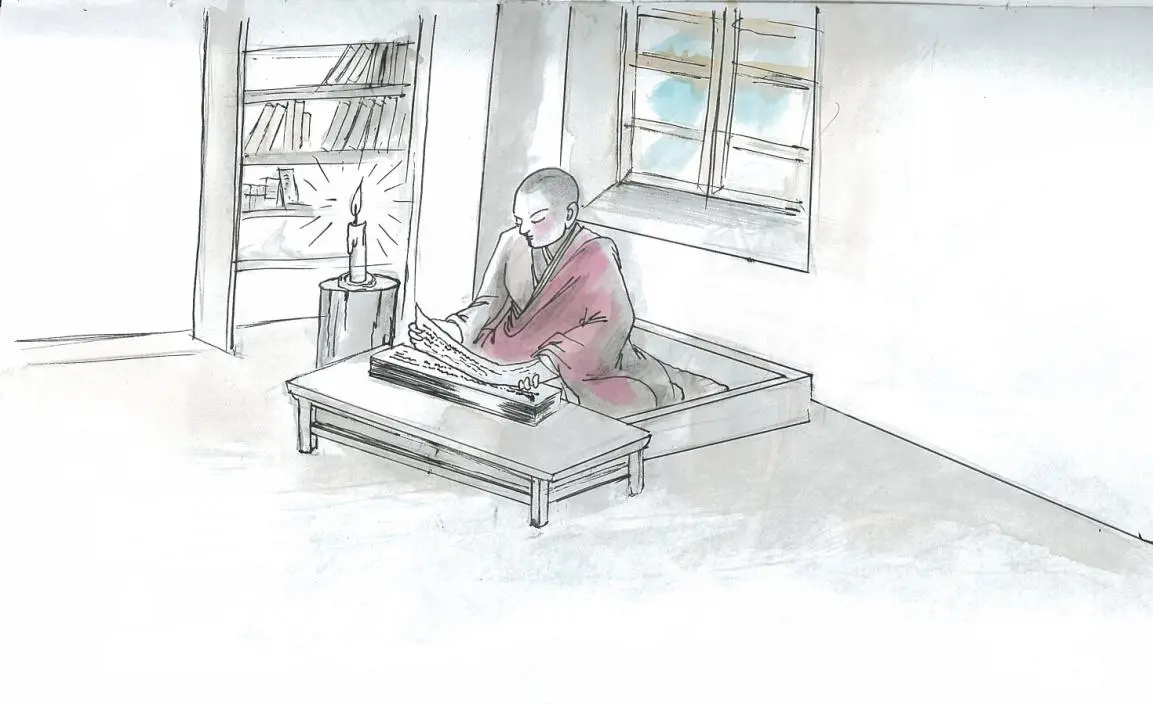
Навестив своего младшего брата в монастыре Кирти, Ринпоче вернулся в Дхартханг для зимнего затворничества. В это время он занимался предварительными практиками великого тертона школы Ньингма, известного как Лама Намчо Мингьюр Дордже. Этот цикл распространялся в основном в традиции Палъюл и назывался «Будда на ладони». В основном он используется как подготовка к практике Дзогчен, считающейся высшим учением в школе Ньингма.
Испытывая огромную преданность к открывателю сокровищ Мингьюру Дордже, Ринпоче приложил особые усилия, чтобы получить полную передачу учений, а затем посвятил дни и ночи выполнению практик. В том числе он вставал рано утром, чтобы выполнить тысячу простираний до завтрака. Благодаря огромному усердию он выполнил 100 000 простираний всего за двадцать один день. В последующие месяцы он продолжал интенсивно медитировать на оставшиеся предварительные практики взращивания Бодхичитты, очищения Ваджрасаттвы, подношения мандалы и гуру-йогу. Затем, завершив предварительные практики, в соответствии с традицией, он в течение месяца медитировал на слог “A”
Следующей весной Ринпоче получил множество учений от очень просвещенного ламы Кхенпо Житена, который временно поселился в Дхартханге. Ринпоче был очень вдохновлен тем, как ясно и структурировано кхенпо излагал Дхарму. С этого момента он стал считать Кхенпо своим Учителем.
После многих месяцев усердной учебы и практики Ринпоче подменял одного из монахов, которого попросили читать учения по «Словам моего совершенного учителя» Патрула Ринпоче. Несмотря на то что он был рукоположен всего год назад, Ринпоче прочитал весь текст по памяти, не допустив ни одной ошибки. Этот случай снискал ему уважение многих сверстников в монастыре.
Ринпоче продолжил обучение практикам стадии завершения — работе с тонкими каналами и ветрами, чтобы контролировать то, что известно как «внутренний огонь» (туммо). В лютый холод тибетской зимы они медитировали на улице, не имея почти никакой одежды для защиты. Хотя большинство учеников не смогли выдержать суровых условий, Ринпоче и еще три монаха прошли месячный ретрит. Хотя этого времени было недостаточно, чтобы овладеть практикой, все же это помогло Ринпоче укрепить стойкость и силу духа.
В последующие годы Ринпоче получил еще больше учений от Кхенпо Житена. Среди них были обширные учения по «Пути Бодхисаттвы» Шантидевы. Следуя его примеру, Ринпоче развил в себе непреодолимое чувство отречения и веру в учения Атиши и великих геше Кадампы. Основываясь на этом чувстве, когда возникли условия, Ринпоче получил полное посвящение от Кхенпо Житена.
1990
Встреча с Коренным Гуру
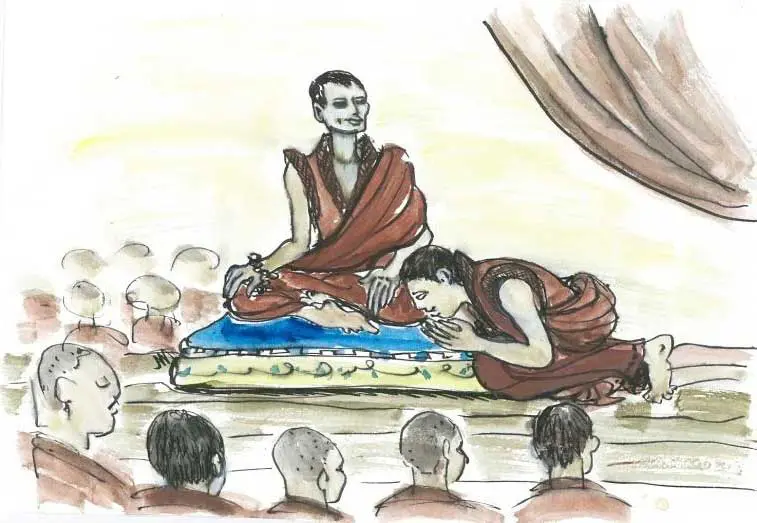
Вынужденный все эти годы преодолевать препятствия, возникающие из-за внутренней политики монастыря, Ринпоче принял решение покинуть Дхартханг. В последнюю ночь пребывания там Ринпоче увидел сон, в котором он вышел к огромной темной реке с крутыми нависающими скалами. Шаг за шагом, Ринпоче успешно пересек реку и взобрался на массивные скальные стены. Добравшись до другого берега, он увидел прекрасную долину, украшенную статуями Будды, рощами и ручьями с кристально чистой водой. Там была женщина в светло-голубых одеждах, сидевшая на белой лошади. Она указала на красивую пещеру и запела на языке, который Ринпоче не понимал, но, тем не менее, истолковал так: «Теперь все твои трудности и препятствия закончились. Теперь ты должен выполнять практику Калачакры там, в этой пещере, и пока ты будешь там, я и многие другие, подобные мне, будем защищать тебя». Проснулся Ринпоче с твердой решимостью совершить трехлетний тантрический ретрит.
Покинув Дхартханг, Ринпоче вернулся домой, а затем отправился в монастырь Джамда, где проходил обучение один из его близких учителей, Тулку Лобсанг Норбу. Там он провел несколько месяцев в затворничестве с другими монахами. Отдохнувший и полный вдохновения, он продолжил свой путь, отправившись в монастырь Се в Амдо Нгава. Именно там Ринпоче выразил желание узнать больше о философии Жентонг традиции Джонанг. Он спросил местного ламу, у кого ему следует просить эти учения, и лама посоветовал ему обратиться к высокореализованному ученому-практику Джецун-ламе Лобсангу Тринле. Услышав его имя, Ринпоче преисполнился великой преданности. Затем он получил указание отправиться в монастырь Чотханг, где лама Лутрин готовился давать учения по Жентонг.
После многих дней пути Ринпоче наконец прибыл в монастырь Чотханг, в этот день монахи делали перерыв в учениях для проведения празднеств. Желая поскорее встретиться с ламой, Ринпоче направился прямо к нему, и представ перед учителем, совершил три простирания. Непритязательный лама излучал силу реализации, когда он увидел Ринпоче, то жестом пригласил его подойти ближе и даже приготовил для него место, используя одну из подушек со своего сиденья. Чувствуя огромное смирение, Ринпоче сидел с Ламой Лутрином, обсуждая Дхарму. Лама задавал Ринпоче множество вопросов о его практике и опыте
После учений в Чотханге Ринпоче сопровождал ламу Лутрина в знаменитый монастырь Дзамтханг Цангва, куда лама Лутрин был приглашен Великим настоятелем ламой Йонтеном Зангпо для проведения учений по Жентонгу. В Дзамтханге проживали более двух тысяч монахов, и он был главным центром традиции Джонанг. Именно здесь по просьбе Ринпоче лама Лутрин опроверг все аргументы, выдвинутые против мадхьямаки ЖентонгТхукеном Лобсангом Чокьи Ньимой в книге «Хрустальное зеркало философских систем». С этого момента Ринпоче обрел непоколебимую веру в учение Джонанг.
1991
Практика в трехлетнем ретрите
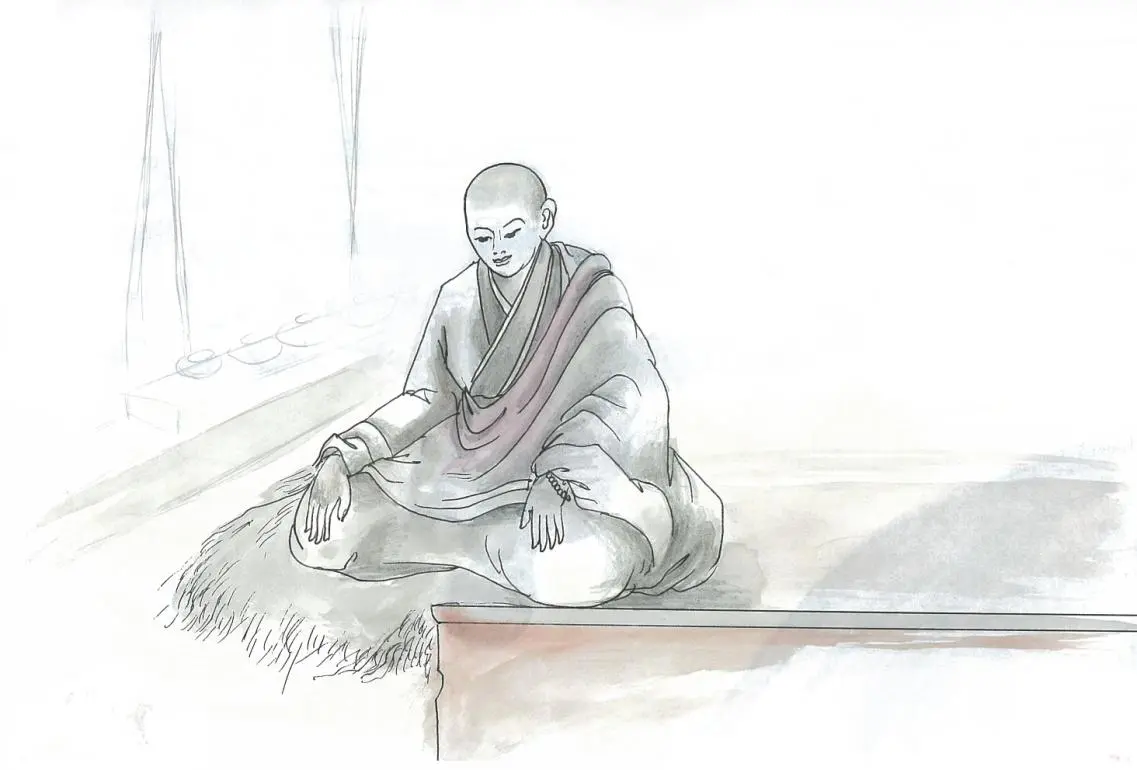
Когда Ринпоче было двадцать три года, ему посчастливилось собрать все необходимые условия для вступления в трехлетний ретрит по стадии завершения Калачакры в монастыре Чотханг. В традиции Джонанг каждый монах должен пройти по крайней мере один трехлетний ретрит. В этом время в ретрите принимали участие одиннадцать монахов, большинство из которых были в возрасте от девяти до восемнадцати лет. Ринпоче и еще один монах были единственными взрослыми монахами в группе. Понимая, что совсем молодым монахам придется преодолевать трудности без посторонней помощи, Ринпоче взял на себя ответственность за их наставничество на протяжении всего ретрита. Вместе монахи занимались предварительными практиками, представленными в тексте Джецуна Таранатхи «Божественная лестница». Параллельно с этими практиками Ринпоче также посещал интенсивные учебные сессии с учеными монахами.
В этот период лама Лобсанг Тринле дал чрезвычайно мощное посвящение Калачакры, в ходе которого Ринпоче почувствовал, как будто весь его опыт трансформировался в мандалу Калачакры из 636 божеств. Во время таких церемоний учитель обычно дарует каждому участнику ваджрное имя. Для этого лама Лутрин попросил Ринпоче составить список имен, а затем положить эти имена в шляпу. Когда настала очередь Ринпоче, он вытащил имя Чойанг Еши Дордже, что означает «Нерушимая изначальная мудрость».
Завершив обычные и особые предварительные практики, Ринпоче погрузился в уникальную практику медитации Калачакры, известную как Три уединения. Эта практика проводится в совершенно темной комнате, где практикующие принимают особую йогическую позу, медитируя на подобную пространству природу ума. Поначалу Ринпоче боролся с неудобством медитативной позы, но благодаря большому упорству он в конечном итоге смог сидеть без боли в течение сессий по два-три часа.
Когда пришло время заняться основными практиками Шести Ваджра-йог, Лама Лутрин выбрал Ринпоче своим помощником. Лама Лутрин учил в течение двух часов, один раз в три-четыре недели. В остальное время Ринпоче отвечал за разъяснение учений для двух групп медитирующих. В дополнение к интенсивному графику медитации Ринпоче часто отказывался от завтрака, чтобы продолжить медитацию или принять участие в учебных сессиях, которые проводились в то время.
В возрасте 26 лет Ринпоче завершил свой ретрит, и вся группа отправилась к Ламе Лутрину для посвящения заслуг от своей практики. Тогда же Ринпоче пообещал своему Ламе провести не менее девяти месяцев в интенсивном уединенном ретрите в отдаленной местности. Лама Лутрин был очень доволен всеми их усилиями и благословил их на успех в практике. После этого они устроили большой ритуал Цок, чтобы отпраздновать свои достижения.
1994
Ринпоче становится Мастером Римè
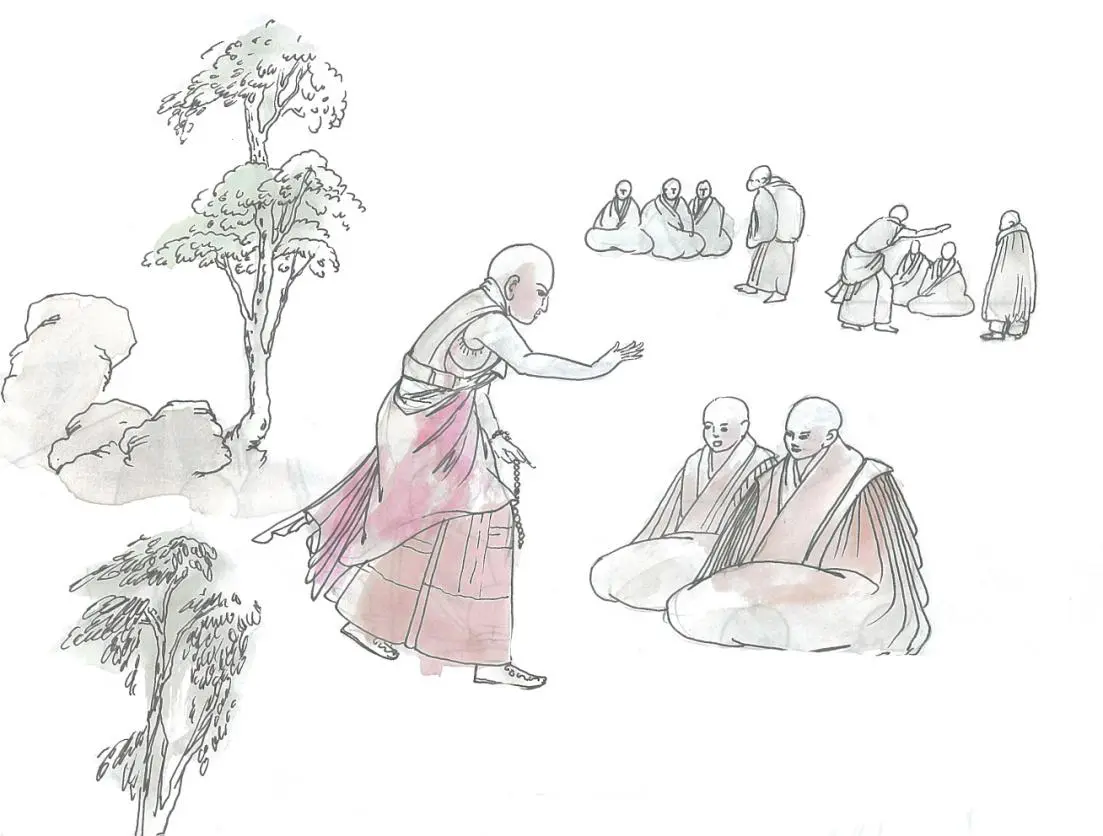
После трехлетнего ретрита Ринпоче начал странствовать из монастыря в монастырь, участвуя в самых разных учениях и ретритах. С неутолимой жаждой Дхармы он не ограничивал себя какой-то одной традицией, а вместо этого сосредоточился на изучении множества учений основных школ.
IЧтобы улучшить гибкость своего ума, он часто вступал в дебаты с учеными каждого из монастырей, занимая позицию другой традиции, чтобы бросить вызов монахам и заставить их мыслить за пределами любых узких взглядов. Например, когда Ринпоче оказывался в монастыре Гелуг, он часто выступал от имени традиции Ньингма. Когда же он оказывался в монастыре Ньингма, он часто выступал от имени Гелуг. Он обнаружил, что этот процесс не только обострил его собственное понимание Дхармы, но и помог развеять большое количество заблуждений, которые исходят от людей, сосредоточенных только на недостатках других традиций. Напротив, он решил подчеркнуть важность признания невероятной ценности, которую представляет собой каждая отдельная линия.
Именно в этот период Ринпоче посетил великий монастырь Ларунг Чогар, основанный Мастером Римè Кхенпо Джигме Пхунцоком. Этот огромный монастырь был пристанищем процветающей общины, построенной на принципах открытого взаимообмена. В монастыре не было установленной программы, которой должны были следовать монахи. Вместо этого ученые могли свободно участвовать в различных занятиях и дебатах, черпая вдохновение из любых традиций. Ринпоче очень нравился этот открытый подход к Дхарме, и именно в этой среде он преуспел.
Время, проведенное в Ларунг Гаре, помогло Ринпоче интегрировать океан учений, которые он получил к тому моменту, кроме того и другим стало ясно, что Ринпоче стал настоящим Мастером Римè. Хотя Ринпоче немного неохотно принимал такого рода признание, в конце концов он стал более комфортно чувствовать себя, осознавая, что он стал опытным ученым-практиком.
В дополнение к растущему чувству уверенности в своих собственных способностях, росла и преданность Ринпоче своему всеведущему учителю, ламе Лобсангу Тринле. Развивая чрезвычайно широкий и обширный взгляд, он смог увидеть удивительно глубокую природу учений, которые он получил от ламы Лутрина. Его наполняло чувство всепоглощающей благодарности и признательности за неизмеримую доброту, которую проявил к нему его лама.
1997
Публичное признание воплощением Нгаванга Чозина Гьяцо
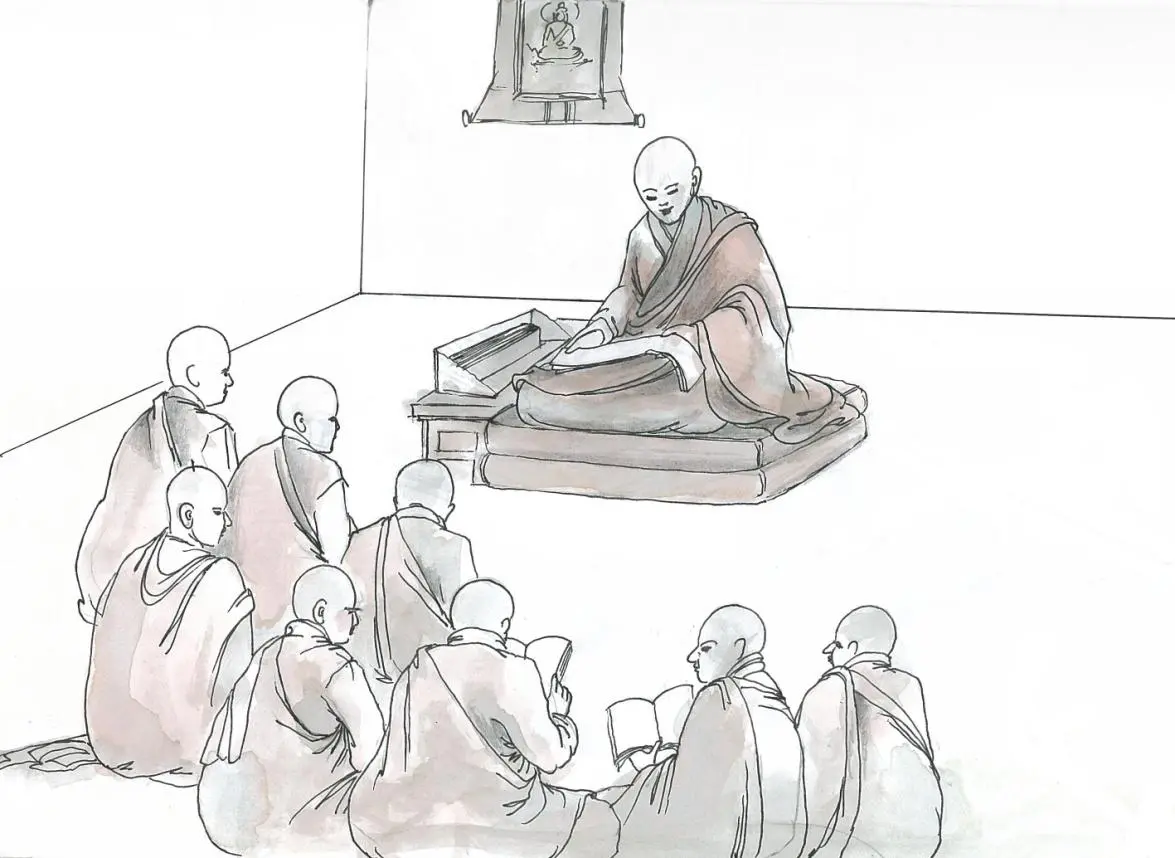
Более двух лет Ринпоче посещал монастыри и поддерживал людей в родной деревне, после чего, наконец, вернулся в Чотханг, чтобы быть рядом со своим Коренным ламой. В это время Ринпоче начал больше узнавать об астрологических системах Тибета. В частности, о системе Нагци, пришедшей из Китая, и о системе Карци, пришедшей из Индии. Последняя во многом основывалась на очень точных расчетах, содержащихся в Калачакра-тантре.
В это время весь монастырь собрался на ритуал Цок. Пока все пели, в зал вошел лама Лобсанг Тринле и попросил мастера песнопений остановиться. Затем он начал давать краткое учение Дхармы о том, как важно различать подлинную практику Дхармы и подлинных учителей Дхармы. В рамках этой беседы он публично похвалил Ринпоче за его многолетнее усердное изучение и практику и особенно за его внесектарный подход.
С того момента, как были сняты ограничения на духовную практику, лама Лутрин присвоил титул «кхенпо» двенадцати своим ученикам. В тот день, когда проходил праздник Цок, он сказал собравшимся, что хочет дать Ринпоче титул «Римè Чодже», что означает «Беспристрастный Владыка Дхармы». Он указал, что это его официальный титул, а в общих контекстах его можно называть Кхенпо. Он также объявил в присутствии более четырехсот монахов, что Ринпоче действительно является реинкарнацией Геце Кхентрула Джигме Джангчупа Гьяцо, и что его следует почитать как такового. В честь этого события Лама Лутрин подарил Ринпоче несколько особенных текстов из своей личной коллекции, а также свой собственный церемониальный головной убор, который он надевал во время каждого своего учения. Получив титул, подтверждение статуса перерожденного ламы и этот символический жест от своего учителя, Ринпоче обрел полномочия держателя линии и духовного наследника Ламы Лобсанга Тринле.
Все это было очень удивительно для Ринпоче, который чувствовал себя неловко, оказавшись в центре внимания после того, как столь долго жил простым монахом. Он никогда не обсуждал с Ламой Лутрином свои семейные тайны, поэтому было еще более удивительно, что его Лама говорит обо всем этом на публике. Позже Ринпоче узнал, что Лама Лобсанг Тринле в частном порядке провел расследование, чтобы узнать больше о прошлых жизнях Ринпоче, поскольку было очевидно, что тот является очень особенным человеком. С этой целью он обратился ко многим высшим ламам и попросил их определить, кем был Ринпоче.
Высшие ламы подтвердили, что Ринпоче был вторым воплощением великого адепта Калачакры, известного как Вашул-лама, Нгаванг Чозин Гьяцо. Этот выдающийся практик был известен своими феноменальными реализациями и являлся учителем коренного гуру самого Ламы Лутрина Нгаванга Тенпы Рабгье и других великих мастеров, таких как Бамда Тхубтен Гелек Гьяцо. Именно Нгаванг Чозин Гьяцо переродился в Геце Кхентрула, который впоследствии родился как Кхентрул Ринпоче Джампэл Лодрё.
1997
Медитация в дикой местности
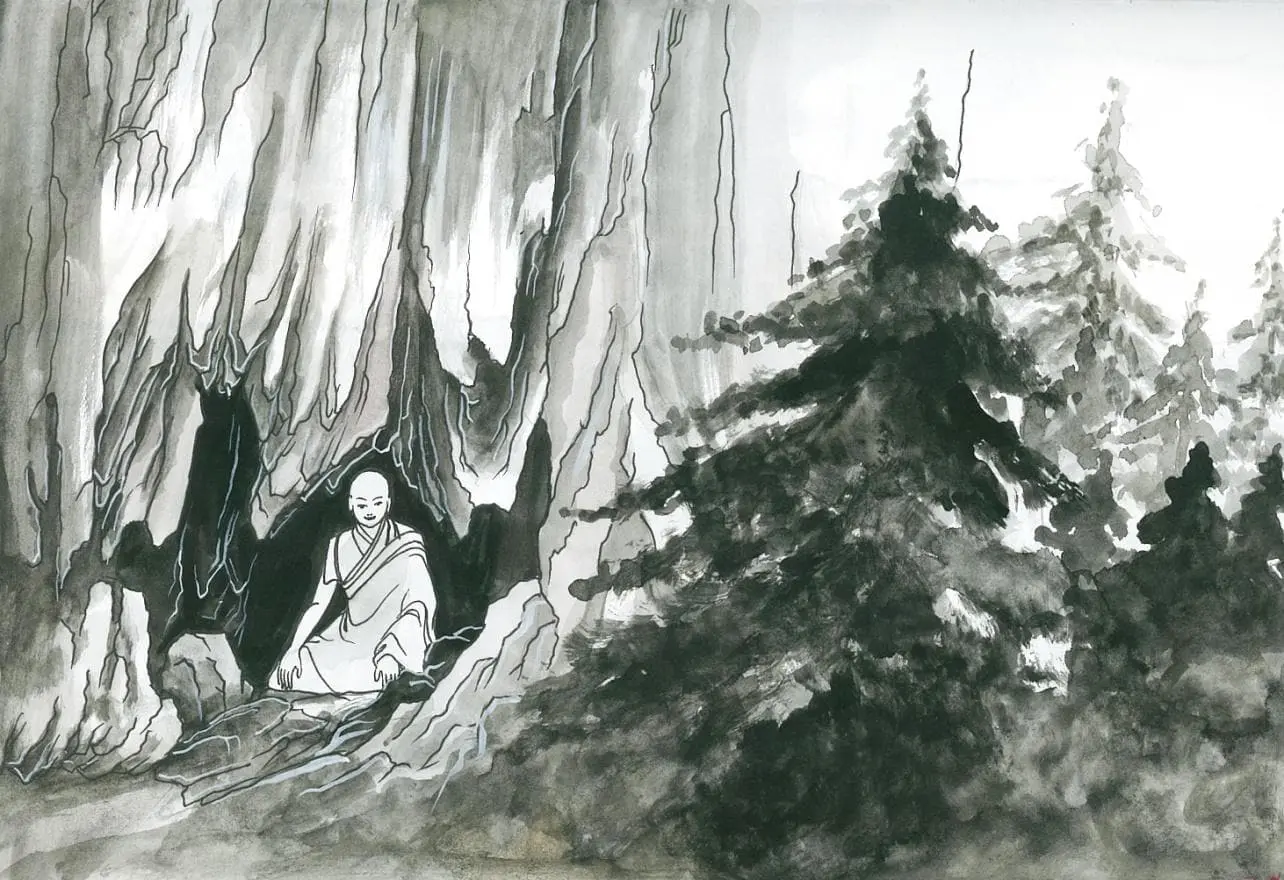
Позже в том же году Ринпоче отправился навестить одного из самых опытных учеников Ламы Лутрина, Кьянгнака Концула, который находился в медитативном ретрите на протяжении всей жизни. Когда они встретились, Кьянгнак рассказал Ринпоче, что накануне его приезда ему приснился очень благоприятный сон, после чего они продолжили очень долгую и оживленную беседу о Дхарме, которая затянулась до самого утра.
Ринпоче отправился в монастырь Дзамтханг Цангва, чтобы провести время с друзьями. Во время его пребывания там настоятель Дзамтханга лама Йонтен Зангпо пригласил Ринпоче зайти в свою келью. Преподнеся ему церемониальный шарф и несколько подарков, Йонтен Зангпо сказал Ринпоче, что тот должен остаться в Дзамтханге и учить монахов. Хотя у Ринпоче не было желания учить, он принял эту должность из уважения к ламе Йонтену Зангпо, который наделил его посвящением Калачакры.
С благословения Ламы Лутрина Ринпоче начал преподавать в Дзамтханге, но быстро обнаружил, что ему это не подходит. Нахождение на руководящей должности в таком большом монастыре означало высокую степень вовлеченности в политику. Стало ясно, что если Ринпоче хочет сохранить чистоту своей практики, ему придется уехать. Поэтому, написав искреннее письмо с извинениями, он отказался от своей должности и решил пойти по стопам таких йогинов, как Кьянгнак Концул, и уйти в уединенное затворничество в глуши Тибета.
Взяв с собой лишь свернутый матрас, несколько одеял и самые необходимые вещи, Ринпоче отправился в лес Дой Аринак, где медитировал такой великий мастер, как Патрул Ринпоче. Собирая подаяние в местных деревнях, Ринпоче накопил достаточно припасов, чтобы продержаться семь недель. Затем он отправился в лес и нашел поляну, где разбил свой лагерь. Исполнившись удовлетворенности и безмятежности, Ринпоче посвятил себя медитации.
В конце седьмой недели, когда запасы Ринпоче были на исходе, его посетили двое детей, одетых в странные одежды. За все время пребывания там он не видел ни одного человека, поэтому был очень удивлен появлением из ниоткуда этих детей. Поприветствовав их, Ринпоче сказал, что скоро собирается пойти за припасами для продолжения ретрита. Дети предостерегли его от этого и сказали, что он должен вернуться домой и повидать свою семью. Они повторяли это много раз, и в конце концов Ринпоче согласился, после чего они ушли.
Через несколько дней Ринпоче, поразмыслив, решил прислушаться к совету этих двух детей и вернуться домой. По дороге он остановился в лесу, чтобы переночевать. Во сне Ринпоче увидел тех же мальчика и девочку, они представились Дамченом и Экаджати, двумя Защитниками Дхармы, которых часто связывают с учениями Дзогчен. Эти двое объяснили, что ему не нужно продолжать лесной ретрит, но вместо этого ему нужно применять свой духовный опыт везде, где бы он ни оказался. Проснувшись ото сна, Ринпоче был полон решимости направить свою жизнь в новое русло.
1999
Путешествие на Запад
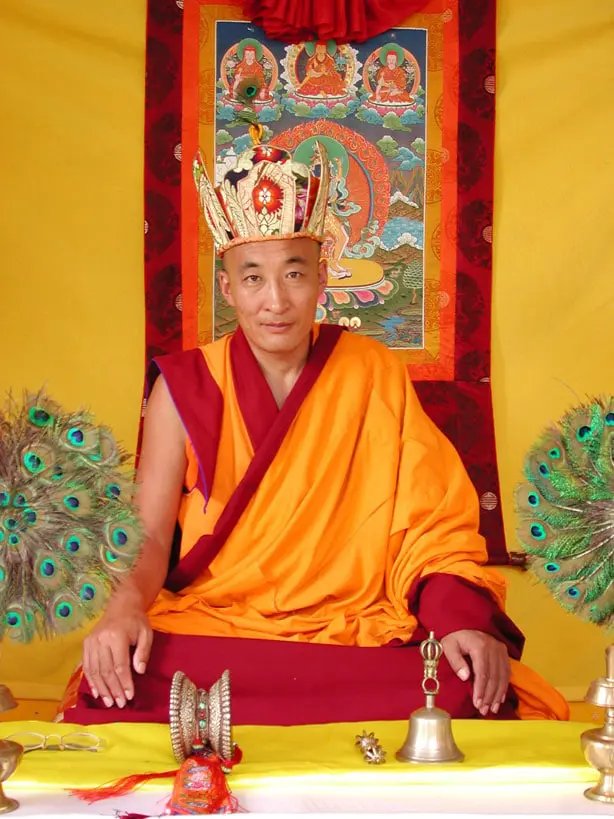
После возвращения Ринпоче в свою деревню жители сразу стали просить его провести множество тантрических ритуалов для их блага. После двух недель ритуалов Ринпоче начал испытывать сильное желание увидеть своего Ламу. Он чувствовал, что происходит что-то важное, и поэтому решил немедленно отправиться в монастырь Чотханг. Когда он прибыл туда, то застал монахов, совершающих пуджу для Ламы Лобсанга Тринле. На людях Ринпоче сказали, что с ламой все в порядке, но затем в частном порядке он узнал, что лама перешел в нирвану всего несколько дней назад. Этот факт держался в секрете, чтобы дать Ламе возможность уединиться для выполнения посмертной медитации, которая длилась пять дней.
Смерть его драгоценного учителя оказала глубокое влияние на Ринпоче. Несмотря на то что Лама предупреждал своих учеников, что умрет в этом году, чувство утраты, которое он испытывал в тот момент, было неописуемым. После участия во всех обширных пуджах и практиках, сопровождающих уход из жизни великого ламы, Ринпоче дал торжественный обет отказаться от всех мирских забот на семь лет. В течение этого времени он не будет навещать свою любимую семью и заниматься делами родного края.
Чтобы выполнить свое обещание, Ринпоче понимал, что ему придется отдалиться от того мира, который он знал до сих пор. Именно тогда у него возникла идея отправиться в путешествие за пределы Тибета. У него появилось стремление посетить чужие земли, выйти за пределы привычного и исследовать новые возможности.
Благодаря созреванию этого стремления в конце концов сложились все причины и условия для переезда в Мельбурн, Австралия. По прибытии он записался на курсы английского языка, чтобы освоиться в общении. Хотя этот мир кардинально отличался от того, в котором он вырос, он всегда был полон решимости и никогда не сдавался. В течение следующих нескольких лет Ринпоче развивал свои языковые навыки и налаживал связи в местном буддийском сообществе.
2005
Первые ученики на Западе
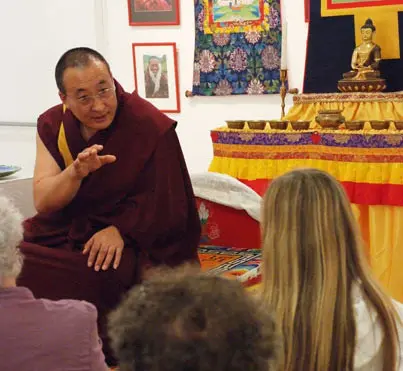
В начале 2005 года Ринпоче получил известие о том, что его мать больна и нуждается в операции. Желая помочь ей, он обратился к буддийскому сообществу с просьбой о пожертвованиях для оплаты операции. В результате Ринпоче познакомился с Джули О’Доннелл, которая впоследствии стала одной из ближайших западных учениц Ринпоче.
Джули пригласила Ринпоче давать учения у себя дома в Апвее (восточный пригород Мельбурна). Раз в неделю они проводили учения в ее доме, а затем по выходным он отправлялся в разные места города, чтобы провести публичные беседы о Дхарме. Несмотря на то, что его английский был еще весьма ограничен, он использовал эти мероприятия, чтобы улучшить свои навыки общения и заложить основы для буддийской общины.
В результате их усилий был основан Тибетский буддийский институт Риме, некоммерческая организация, которая должна была поддерживать реализацию проектов Ринпоче. Примерно в это время они переехали в новый дом в соседнем пригороде Роувилл, что позволило им расширить свою деятельность.
В Роувилле Ринпоче продолжал давать еженедельные учения по основам тибетского буддизма, а также начал проводить практические ретриты для все растущего числа учеников. В то же время он стал проявлять больше активности, предлагая множество публичных бесед на темы счастья и медитации. Он также проводил церемонии благословения и похоронные обряды для тех, кто просил его об этом.
В этот период Ринпоче вместе с Джули и другими добровольцами работал над составлением истории его жизни и собранием его наставлений. На основе этих материалов они подготовили первое издание его автобиографии под названием «Тайное воплощение» и новую отшлифованную версию его книги о Риме под названием «Путь чистого видения».
2006
Возвращение в Тибет
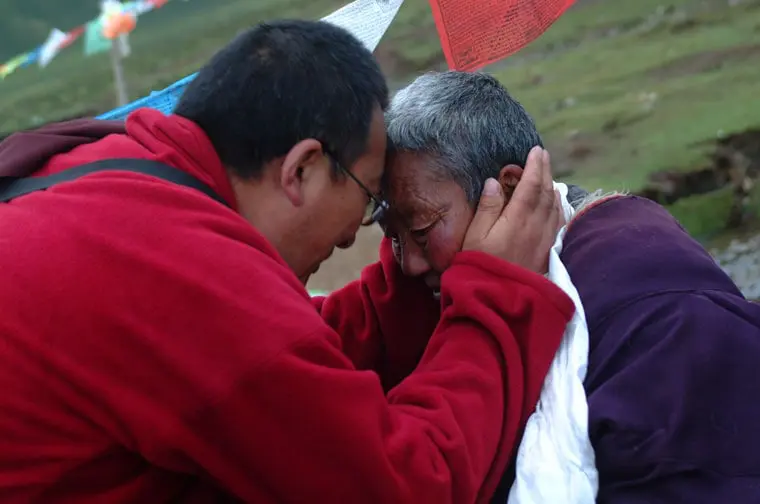
Спустя семь лет после того, как Ринпоче дал обещание своему драгоценному гуру, ламе Лобсангу Тринле, Ринпоче наконец создал условия для возвращения в Тибет и воссоединения со своей семьей. Благодаря щедрым пожертвованиям, которые Ринпоче получил от своих западных учеников, он собрал достаточно денег не только для оплаты операции своей матери, но и для поездки в Тибет, чтобы лично увидеться с ней.
Вместе с небольшой группой западных студентов Ринпоче собрал множество чемоданов с подарками для своей стареющей матери, родственников и жителей своей деревни. Когда они направились в Голок, их встретили толпы монахов, приехавших со всех концов страны, чтобы приветствовать его дома и предложить ему белые шарфы для благословения. Посреди горной поляны они поставили палатку с угощениями. Вместе с друзьями, которых он не видел с тех пор, как покинул Тибет, Ринпоче устроил большое пиршество.
Вскоре после того, как он продолжил свой путь домой, дороги закончились, и Ринпоче пришлось перегрузить весь свой багаж и припасы на сорок яков, собранных в большой караван. Ринпоче дали белого коня, украшенного флагами, на котором он ехал во главе длинной процессии. Медленно они пробирались через горные перевалы и прекрасные летние долины, где прошло детство Ринпоче.
Когда они приблизились к месту назначения, все жители деревни и окрестностей вышли поприветствовать Ринпоче. Они стояли в длинной очереди, ведущей к его дому. Каждый держал в руках шарф для подношения и радостно приветствовал Ринпоче, проезжавшего мимо. Звуки тибетских рожков и барабанов эхом разносились по горам, возвещая о прибытии Ринпоче.
Подъезжая наконец к дому своей матери, Ринпоче был полон радости, он сразу же направился к ней и прикоснулся своей головой к ее голове, как это принято в Тибете. Они оставались в таком положении в течение долгих минут, как будто никогда не хотели расставаться. Со слезами на глазах они в конце концов пошли в дом, чтобы поговорить и отпраздновать его возвращение. Это прекрасное воссоединение оказалось их последней встречей, поскольку она скончалась в следующем году.
После общения с матерью Ринпоче и его западные ученики отправились в монастырь Чотханг, по пути посещая различные монастыри, в том числе монастырь Джамда и Дзамтханг Цангва. Как и в случае с его приемом в Голоке, сотни монахов выстроились на улицах, чтобы приветствовать Ринпоче и оказать ему почести.
С тех пор Ринпоче провел более шести туров по Восточному Тибету. Эти поездки не только позволяют ему познакомить западных учеников с богатым духовным наследием, которое до сих пор процветает в этом регионе, но и помогают ему поддерживать прочные связи со многими великими практикующими, которые живут там. Благодаря этим связям Ринпоче надеется принести благословения линии передачи в мир.
2007
Основание Тонг Зук Дэчен Линга
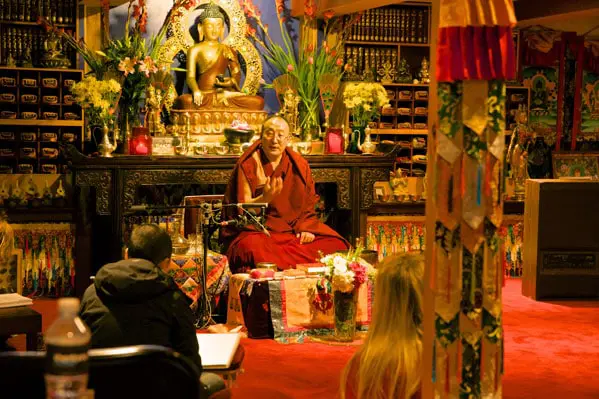
Вернувшись в Австралию, Ринпоче понял, что для того, чтобы помочь его молодой общине продолжать расти, Институту Римè необходимо постоянное место, которое они могли бы называть домом. Для этой цели он начал искать недвижимость, которая могла бы стать основой для будущего Дхарма-центра. После изнурительных поисков он в конце концов нашел прекрасный дом в небольшом городке Белгрейв, укрывшемся в ярких лесах гор Данденонг к востоку от Мельбурна.
Переехав, Ринпоче вместе с командой волонтеров приступили к работе по ремонту дома и строительству храма, где студенты могли бы получать учения и практиковать медитацию. Пока Ринпоче продолжал проводить еженедельные занятия и ретриты в верхней части дома, нижний этаж постепенно преобразился в прекрасное пространство для духовной практики, наполненное необыкновенными благословениями. Когда процесс строительства был завершен, Ринпоче отпраздновал это достижение, дав центру название Тонг Зук Дечен Линг что означает «Место Пустой Формы и Великого Блаженства».
AПоскольку члены общины продолжали учиться под искусным руководством Ринпоче, сам Ринпоче был сосредоточен в первую очередь на создании учебных материалов для своих учеников. Понимая, что для западных людей, заинтересованных в практике Пути Калачакры, существует очень мало ресурсов, он решил передать свои обширные знания в форме серии книг.
Одной из первых книг, выпущенных в Тонг Зук Дечен Линге, была «Скрытое сокровище Глубинного Пути»; — дословный комментарий к «Божественной Лестнице», который он изначально написал на тибетском языке, а затем перевел на английский и китайский языки. Затем в тесном сотрудничестве с рядом волонтеров Ринпоче выпустил книгу под названием «Жить счастливее», в которой основное внимание уделялось практическим советам по достижению подлинного счастья. В то же время он продолжал придавать форму своему основному тексту «Раскрытие вашей сокровенной Истины»— обширному сборнику учений, описывающему весь путь подробно и шаг за шагом, чтобы способствовать постепенному развитию своих учеников.
2014
Распространение Учения Калачакры
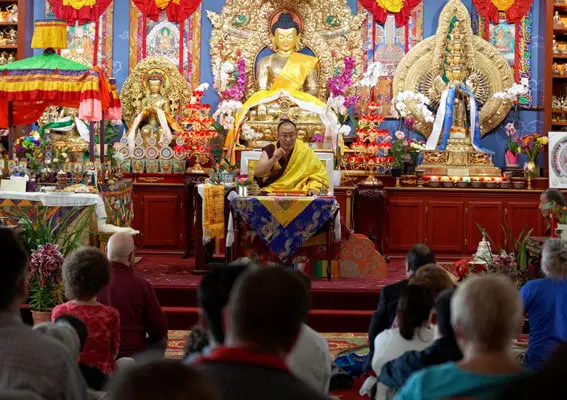
В 2014 году, после многих лет настойчивых усилий по ознакомлению западных учеников с Учением Калачакры, Ринпоче встретил канадца по имени Джо Фламерфельт, который вскоре переехал в Мельбурн, чтобы работать с Ринпоче. Вместе они сосредоточились на расширении материалов, уже разработанных Ринпоче, чтобы вполне реализовать его видение. Результатом их сотрудничества стали две оригинальные книги. Первая, под названием «Океан разнообразия», расширила существующую книгу Ринпоче о Римè, включив в нее все основные мировые традиции мудрости и его собственные учения о том, как развивать философию Римè. Вторая, под названием «Демистификация Шамбалы», расширила небольшую книгу, в которой была подробно описана история традиции Джонанг в Тибете. В эту книгу также вошло подробное объяснение Ринпоче взаимосвязи между Шамбалой и Калачакрой. В дополнение к этим работам материал, представленный в «Раскрытии вашей сокровенной истины» был переструктурирован и значительно расширен, в результате чего получился трехтомник.
Пока готовились эти новые дополнения к его сборнику, Ринпоче приглашали давать учения в самых разных городах мира. В ходе своего первого мирового турне Ринпоче посетил многие европейские страны, такие как Румыния, Венгрия, Австрия, Италия и Греция. Затем он отправился в Соединенные Штаты, где посеял семена Дхармы на американском Среднем Западе. В следующем году Ринпоче вернулся во многие из этих стран, чтобы продолжить наставлять растущее число преданных учеников. Именно в это время Ринпоче начал давать сокращенную версию Посвящения Калачакры в рамках своих учений.
К 2017 году Ринпоче успешно заложил основу для создания глобальной сети последователей Калачакры: в нескольких городах появились группы практикующих. Благодаря различным крупным мероприятиям Ринпоче получил возможность представить множество своих новых книг, а также установить большое количество значимых связей с людьми со всего мира. С тех пор Ринпоче продолжает давать учения более чем в двадцати странах, неустанно знакомя людей с учениями Калачакры и обучая их практике.
2018
Манифестация Золотого Века Мира и Гармонии
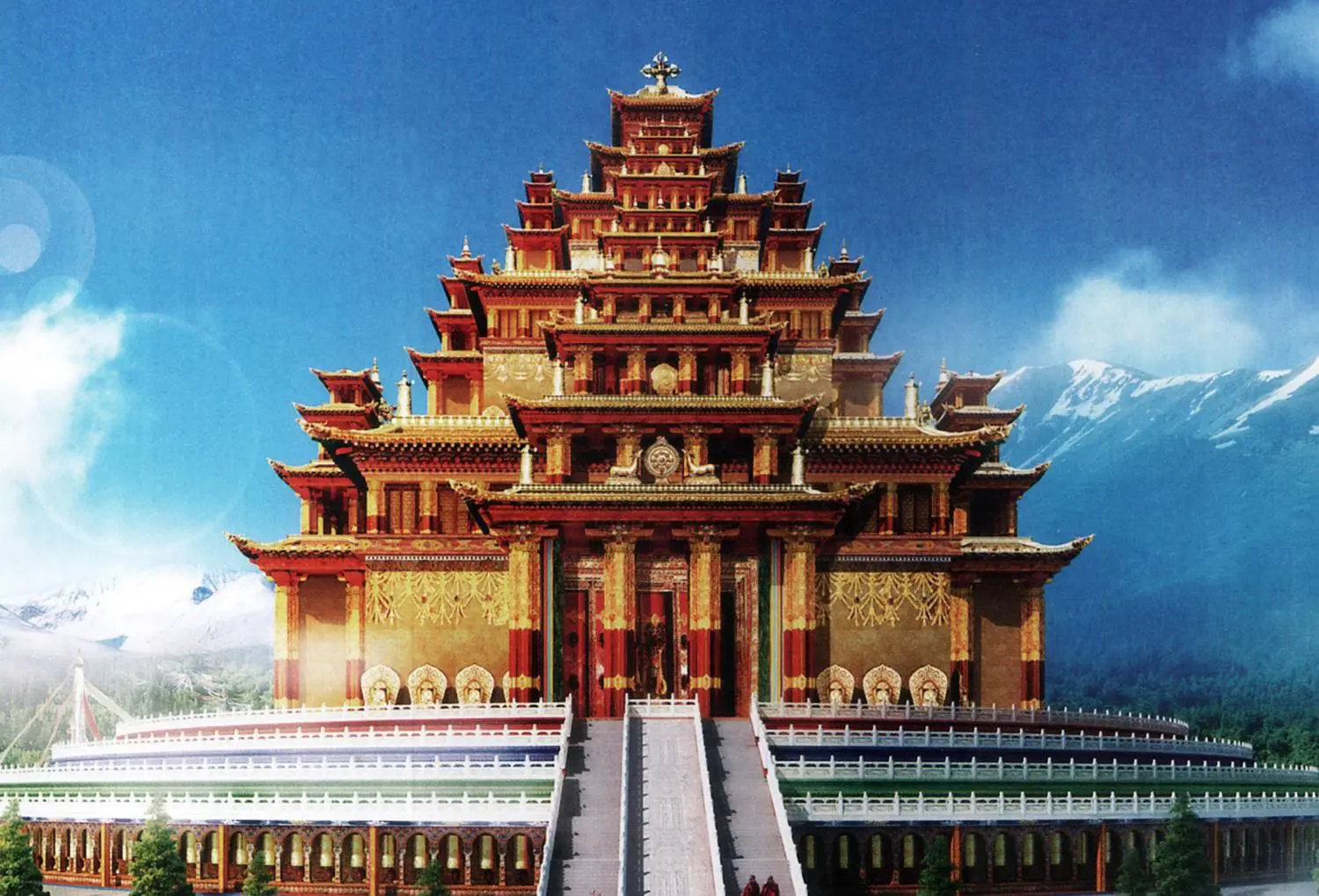
В 2018 году Кхентрул Ринпоче основал Дзокден — международную сеть, объединяющую людей, группы практикующих, учебные институты и ретритные центры. Его миссия — создание условий для глобального мира и гармонии посредством практики учений Калачакра-тантры. Хотя Дзокден охватывает огромное разнообразие традиций мудрости, явленных в этом мире, он специализируется на глубоком пути Ваджра-йоги — уникальных учениях стадии завершения Калачакры, как они представлены в традиции Шамбалы Джонанг.
Посредством Дзокден Кхентрул Ринпоче представляет мир без ограничений, мир, где каждый имеет возможность раскрыть свой бесконечный потенциал и где — независимо от общества, к которому мы принадлежим, или традиций, которым следуем — все мы сможем сплотиться в одну всемирную семью, единую в нашей совершенной природе. В таком мире, свободном от всех форм предвзятости, наши умы будут пребывать в полном согласии и гармонии, обеспечивая идеальное равновесие и расцвет духовности на этой планете.